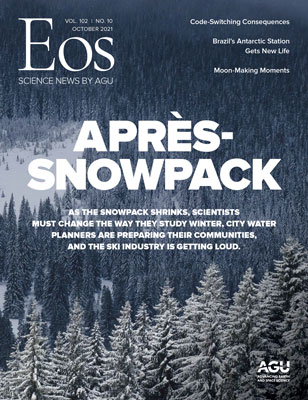The polar vortex is a media darling. Headlines frequently announce that it’s coming, collapsing, or splitting, and articles often tout its role in record-setting winter storms. But misconceptions about this atmospheric phenomenon abound, and scientists are still untangling its effects on our weather. Here’s a rundown of what the polar vortex really is.
Swirling Air in the Stratosphere and Troposphere
First off, a definition: The term, a shortening of “circumpolar vortex,” typically refers to a swirling mass of air at far northern or southern latitudes. “It’s a region of high wind speed that encircles the pole,” said Jacob Shultis, an atmospheric scientist at Johns Hopkins University in Baltimore.
There’s a polar vortex in the planet’s stratosphere, and that’s the one that usually makes the news. But there’s also a similar structure lower in the atmosphere: the tropospheric polar vortex. Also known as the jet stream, the tropospheric polar vortex functions to corral cold air near the pole. Like its higher-altitude cousin, the tropospheric polar vortex is a region of westerly (west to east) flowing winds. However, it’s significantly larger—it can extend antipoleward to latitudes of roughly 40°–50°. (Its winds explain why eastbound flights across the United States are shorter than westbound flights.)
These two polar vortices appear at different times of the year: The stratospheric polar vortex develops in the fall and dissipates in the spring, whereas the tropospheric polar vortex is a year-round phenomenon. When these vortices do happen to overlap temporally, they’re still separated by kilometers of vertical airspace, however. “More often than not, they’re kind of doing their own thing,” said Laura Ciasto, a meteorologist at NOAA’s Climate Prediction Center in College Park, Md.
The Flow Breaks Up
That sometimes changes, however. Undulations in Earth’s atmosphere caused by temperature gradients—known as Rossby waves—can travel from the troposphere to the stratosphere, where they can disrupt the stratospheric polar vortex and cause its westerly winds to weaken. When that happens, the stratospheric polar vortex stops being a circular flow centered on the pole and instead becomes more wavey, said Ciasto. “You tend to see more north–south flow rather than just west–east.”

These events, which are known as sudden stratospheric warmings, can have extreme effects on the stratospheric polar vortex, said Zachary Lawrence, an atmospheric physicist at the University of Colorado Boulder. “It can split apart into two separate vortices. It can be pushed very far off the pole.”
These variations in the stratospheric polar vortex can have far-reaching effects beyond the upper atmosphere—they can affect the weather that we experience on the planet’s surface. That’s because sudden stratospheric warmings can cause the tropospheric polar vortex to expand equatorward, sending blasts of cold air to lower latitudes. That’s likely what happened in February of this year, when a record-setting ice storm pummeled wide swaths of North America.
Using satellite data, it’s possible to detect sudden stratospheric warmings, which occur about once every year or so. But it’s impossible to know how the tropospheric polar vortex will respond and what regions might be subject to a cold snap, said Ciasto. “Even though there might be a sudden stratospheric warming, that doesn’t necessarily mean that the United States is going to feel the impact.”
Environmental and Climatic Links
Environmental conditions can also affect the behavior of the stratospheric polar vortex. For instance, recent decreases in Arctic sea ice cover—triggered by climate change—have been linked to a more unstable stratospheric polar vortex.
Climatic phenomena can play a role, too. For instance, El Niño conditions—warmer-than-average surface waters in the Pacific and weaker-than-normal easterly trade winds—boost the probability of sudden stratospheric warmings. That’s because they can drive the formation of destabilizing Rossby waves, said Lawrence. “El Niño events affect the generation of waves in the troposphere.”
Peering at Other Worlds
Polar vortices aren’t unique to Earth. Venus, Mars, and several of the gas-dominated bodies in the outer solar system all have them, too. Johns Hopkins University’s Shultis and his colleagues are studying the polar vortex on Titan, Saturn’s largest moon, using data collected by the Cassini spacecraft.
Shultis and his collaborators run computer models based on Cassini data to better understand the structure of Titan’s polar vortex. Modeling is important because the observations—amassed over 13 years while Cassini was orbiting Saturn—don’t extend over a full Saturnian year, said Shultis. That makes it difficult to trace the seasonal evolution of Titan’s polar vortex, he said. “We’re really interested in looking at how it evolves over time.”

So far, the researchers have found hints that Titan’s polar vortex weakens in the middle of winter. That’s very unlike the behavior of Earth’s stratospheric polar vortex and a big surprise, said Shultis. Titan’s global circulation patterns might be at play, the researchers hypothesize: Air is known to descend over the pole that’s experiencing winter, and that movement compresses the air, warming it. That warming, in turn, decreases the local temperature gradient that powers the polar vortex, Shultis and his collaborators suggest.
“Any planet that has a substantial atmosphere could possibly have one.”
Polar vortices likely exist on other unstudied worlds, too. “Any planet that has a substantial atmosphere could possibly have one,” said Shultis. New instruments will extend our ability to study celestial bodies farther out in the solar system—and possibly beyond—but Earth’s polar vortices will likely always be around for a close-up look. They’ve persisted for billions of years, and they show no signs of relinquishing the spotlight anytime soon.
—Katherine Kornei (@KatherineKornei), Science Writer
Citation:
Kornei, K. (2021), The who, what, when, where, and why of the polar vortex, Eos, 102, https://doi.org/10.1029/2021EO158321. Published on 12 May 2021.
Text © 2021. The authors. CC BY-NC-ND 3.0
Except where otherwise noted, images are subject to copyright. Any reuse without express permission from the copyright owner is prohibited.


